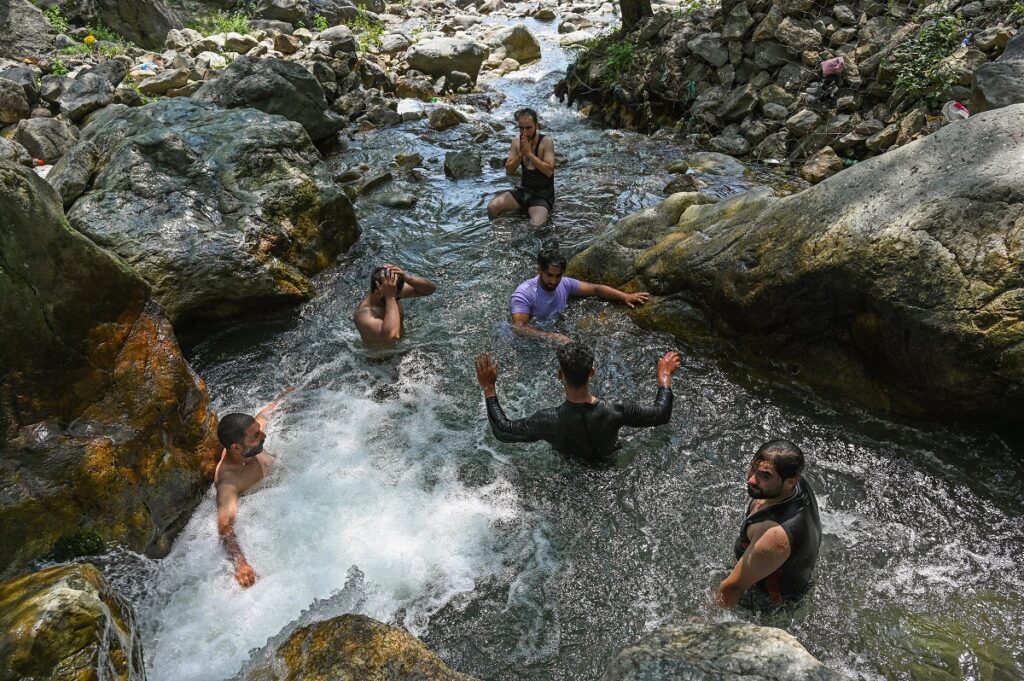Understanding Today’s Weather Forecast, Heat Impacts, and What It Means for the Future
June brings more than just school vacations and saffron-scented air in Kashmir. This year, it has ushered in an unusually persistent heatwave, transforming even the high-altitude Valley into a sweltering zone that feels more like Delhi or Hyderabad. Today, the India Meteorological Department (IMD) has forecast another round of hot and humid weather across several states—including Jammu & Kashmir, parts of North India, West Bengal, Andhra Pradesh, and even Sindh across the border.
This is not just about weather anymore—it’s about climate discomfort, public health, ecological stress, and infrastructure vulnerabilities. In this expanded editorial, we explore what today’s forecast means on the surface and underneath it, with a deep dive into causes, consequences, and climate insights tailored to regions like Kashmir and North India.
What Today’s Weather Forecast Really Means
Interpreting the Meteorological Department’s Advisory
The MeT Department has warned that temperatures today are expected to exceed seasonal norms, particularly in:
-
North Indian states like Punjab, Haryana, and Delhi NCR
-
West Bengal, including Kolkata
-
Andhra Pradesh’s interior and coastal belts
-
Kashmir, where temperatures have already hovered above 35°C this week
-
Sindh in Pakistan, where heatwave alerts have also been issued
Expected Weather Characteristics:
-
Temperature Range: 36°C to 44°C in plains; 29°C to 35°C in hill states like J&K
-
Humidity Levels: 60% to 80%, making it feel even hotter
-
Heat Index (Discomfort Index): 45°C+ in urban areas
-
Rainfall: Very low probability except isolated coastal or hilly thunderstorms
-
Wind Pattern: Warm westerlies with low moisture circulation inland
In simpler terms: it’s not just hot, it’s sticky, suffocating, and straining—especially in overcrowded towns and concrete-heavy urban centres.
Kashmir’s Heatwave: Not a Passing Phase
From Cool Alpine Comfort to Boiling Valleys
In Kashmir, the summer of 2025 has already broken records. Srinagar witnessed its hottest June day in over a decade with 35.6°C, while Anantnag, Kupwara, and Baramulla have all reported sustained high temperatures combined with unusually high humidity—a rare mix for the region.
Why Kashmir’s Heat Is Especially Alarming:
-
Altitude Deception: The Valley’s elevation often misleads people into thinking they’re safe from intense heat.
-
Architecture Mismatch: Traditional homes with wooden structures, tin roofs, and no insulation trap heat during extended spells.
-
Limited AC Infrastructure: Air conditioning remains rare in most homes, schools, and government buildings.
-
Agricultural Stress: Early heat impacts apple blossoms, saffron crops, and water-intensive paddy fields.
Real Impacts:
-
Students fainting in school assemblies due to extreme heat
-
Increased hospital visits for heat exhaustion, especially among seniors and children
-
Spike in electricity demand, leading to frequent power cuts
-
Rapid glacier melt, causing stream levels to swell unpredictably
This is no longer about discomfort. It’s about adapting a region historically designed for cold to a future growing unrecognisably hot.
The Science Behind the Sweat
Understanding Why It’s Hotter Than Normal
Today’s hot and humid forecast is part of a wider pattern triggered by both global warming and regional climate shifts. Here’s how:
Key Climatic Triggers:
-
Climate Change: Global temperatures have risen by 1.2°C since pre-industrial times, intensifying heatwaves across South Asia.
-
Urban Heat Islands: Cities like Delhi, Hyderabad, and even Srinagar trap heat due to dense construction and lack of green spaces.
-
Low-Pressure Disruption: Systems that usually bring rainfall are either weak or diverted, denying relief.
-
El Niño Effect: This Pacific Ocean warming phase alters wind and monsoon patterns, often increasing dryness and heat.
Why Humidity Feels Worse:
When you sweat, your body cools down as the sweat evaporates. But in humid weather, air is already saturated with moisture, so sweat doesn’t evaporate easily—you stay wet, hot, and uncomfortable.
Health Alert: The Silent Toll of Heat
How Heat and Humidity Attack Your Body
High heat combined with sticky humidity doesn’t just feel awful—it poses real risks, particularly for:
-
Children
-
Elderly people
-
Outdoor workers
-
People with respiratory or cardiac conditions
Top Heat-Related Health Risks:
-
Heatstroke and Heat Exhaustion: Dizziness, nausea, disorientation
-
Dehydration: Excessive sweating without water intake causes weakness
-
Respiratory Stress: Poor air quality combined with heat worsens asthma
-
Hypertension Surges: Blood pressure spikes under thermal stress
-
Insect-Borne Illnesses: Hot, moist environments breed mosquitoes
Signs You Shouldn’t Ignore:
-
Skin feels hot and dry despite sweating
-
High fever, shallow breathing
-
Confusion or unconsciousness
-
Muscle cramps and fatigue
-
Fast pulse and vomiting
What to Do:
-
Hydrate regularly (but not just with cold sodas!)
-
Stay indoors between 11 AM and 4 PM
-
Use damp cloths or cold compresses
-
Wear loose, light-colored cotton clothes
-
Avoid strenuous activity or caffeine
Humidity and Mental Health: The Invisible Strain
Why Muggy Days Make You Moody
It’s not just your body that suffers—heat affects your mind too.
Studies show that on extremely hot and humid days:
-
Irritability increases
-
Sleep quality drops
-
Cognitive focus diminishes
-
Depression and anxiety symptoms worsen
In Kashmir, where socio-political uncertainty already strains the population, the added discomfort of heat can worsen mood disorders and trigger stress eating, insomnia, or emotional withdrawal.
Heat and the Environment: Kashmir’s Fragile Balance
How Today’s Weather Affects Tomorrow’s Resources
Kashmir’s ecology is temperature-sensitive. What seems like a few days of hot and humid weather can set off chains of ecological consequences, including:
Immediate Environmental Impacts:
-
Glacier melt accelerates, feeding rivers with flash floods
-
Soil moisture drops, impacting farming and increasing dust
-
Wildfire risks rise, especially in drier forest belts of Jammu
-
Biodiversity stress—birds, insects, and fish struggle to cope
Long-term Consequences:
-
Water sources like Verinag springs and Lidder river face drying threats
-
Crops like apples, saffron, and walnuts suffer quality reduction
-
Aquatic life in Dal Lake is threatened due to oxygen depletion
This is climate disruption in action—not a distant theory, but today’s weather shaping tomorrow’s harvest, water security, and wildlife.
Weathering the Day: What You Can Do
Personal and Community-Level Action
Even if governments lag in action, individuals and communities can make a real difference in adapting to and managing heat stress.
Daily Survival Tips:
-
Drink 8-10 glasses of water; add lemon, mint, or ORS
-
Avoid metal utensils in the sun—they trap heat quickly
-
Use wet towels or sprays on windows for evaporative cooling
-
Make DIY coolers with clay pots or frozen bottles in front of fans
-
Stay in ventilated, shaded spaces—even under a tree is better than inside a tin-roofed shop
Community Initiatives:
-
Organize water stations for pedestrians
-
Set up cooling shelters in mosques, temples, schools
-
Run awareness campaigns about heat exhaustion symptoms
-
Plant shade trees in markets, hospital entrances, and schools
Policy Matters: What Governments Must Do
Time to Act Beyond Advisories
Issuing forecasts is not enough. Governments must treat heatwaves and humidity spikes as natural disasters with systemic impact.
What Should Be Prioritized:
-
Heat Action Plans (HAPs): Like Ahmedabad’s successful model
-
Early Warning Systems: Tailored alerts via mobile SMS in local languages
-
Green Architecture Mandates: Encourage cool roofs, natural ventilation
-
Workplace Regulations: No outdoor labour during peak hours
-
Urban Planning Reforms: More parks, fewer heat-absorbing concrete jungles
In Kashmir, urgent upgrades are needed in:
-
School infrastructure (add fans, thermal insulation)
-
Health systems (train staff for heatstroke response)
-
Agricultural scheduling (adjust sowing/harvest windows)
The Road Ahead: Weather Today, Climate Tomorrow
From Daily Forecasts to Long-Term Survival
Each day of hot, humid discomfort is a climate warning sign. The need now is not just for umbrellas or water bottles, but for resilience, sustainable practices, and community awareness.
Building a Climate-Smart Future:
-
Encourage climate literacy in schools
-
Promote sustainable cooling solutions—like solar-powered fans
-
Shift to climate-resilient crops in farming
-
Demand stronger emission controls and green commitments
Bottom-Line: Don’t Just Beat the Heat—Understand It
Today’s hot and humid weather isn’t just an uncomfortable inconvenience—it’s a preview of the climate reality India and Kashmir must confront. From physical health to ecological stability, the effects are layered and long-lasting.
But with awareness, preparation, and collective action, we can move from suffering to strategy. Whether you’re a farmer in Pulwama, a student in Delhi, or a policymaker in Kolkata—this weather speaks to you. The question is: are we ready to listen?




